PEP 精通版《英语》五(下)Unit 4 What’s wrong with you? Fun story
执教/高 蕾 评析/赵云霞
一、故事前
1.经验谈论,激活故事。
T:Good morning,boys and girls.
Ss:Good morning,Ms Gao.
T:Nice to see you again.
Ss:Nice to see you,too.
T:Today,we are going to enjoy a story.Do you like stories?
Ss:Yes,I do.
T: That’sgreat!Wehave already read a lot of stories about Micky and Mimi. So please tell me what you think of them.Please use“I think Mickey is...I think Mimi is...”.Who wants to try?

S1:I think Micky is clever.I think Mimi is lovely.
T:Quite good.Thank you.Ilike yourideas.Whatabout your idea?
S2:I think Micky is smart.Mimi is cute.
T:Thank you so much for sharing yourideas.How about you?
S3:I think Micky is“淘气的”,Mimi is pretty.
T:Thankyou.Ihavethe same ideas with you.Micky is always very naughty.(教读两遍)Who isvery naughty in your class?
S4:...is naughty.
T:All right.Although you are naughty,you obey the class rules.You are a good student.So much for this.Today we are going to enjoy a funny story about Micky and Mimi,too.(教师板书小猴子和小猫咪的头像)
2.观察图片,预测故事。
T:Look at this picture.What’swrongwithMimi?Can you guess?

S5:Maybe she is ill.
T:That’s right she is ill.Maybe she has a...
S6:Maybe she has a fever.
S7:Maybe she has a cough.
(学生会说出各种疾病,教师要给予及时的回应。)
T: Maybe.Now let’ssee.Look! Mimi is in bed.Maybe she has a...
Ss:Stomachache.

T: That’s right.Mimi has a stomachache.Whatdid she say?
Ss:Ihave a bad stomachache.(出示句子)
T:When you have a stomachache,are you feel happy?Of course not.If you are Mimi,how to say that one?Ah-ha,I have a bad stomachache.
Ss:No.
T:Well,how to say?
S8:Ihave a bad stomachache.(引导学生加上动作)
T:Can you act it out?
S8:再试一次。
再指名三位同学并及时给予鼓励。
T:Look! Micky is coming.If you are Micky,what will you say to Mimi?

S9:How are you,Mimi?
S10:What’s wrong with you?
S11:Let’s go to school.
S12:Can you play with me?
T:You allhave creative ideas. Let’s listen to what Micky said.(教师播放录音)What did you hear?(请学生重复一遍)Who can try?(请个别学生说一说,做出表情)
同学们试着说一说、演一演。
T:If you are Micky,what will you say?
S13:Oh dear,Mimi.Do you have a stomachache?
S14:You should gotoa doctor.
S15:You look bad.
T:You are allvery kind.Let’s listen to what Micky said.(播 放 录 音)Let’s try together.Let me take you to the hospital.

点评:故事正式开始前,高老师通过一个开放性的问题引领,即询问故事主人公的性格特点,激活了学生对已有主人公的了解,也激活了故事背景和已有的知识经验。同时通过图片观察进行故事预测,极大地调动了学生学习故事的积极性。
二、故事中
1.问题贯穿,图片环游。
T:Then they come to the hospital.Can you imagine what happened in the hospital?Please talk with your partner,try to image what they will say.And let’s act.(请同学们想想场景,表演看病的情境)

T:Which pair wants to show?
S16:Hello, what’s your name?
S17:My name is Mimi.
S16:How old are you?
S17:I’m ten.
S16:What’s wrong with you?
S17:I have a stomachache.
S16:You should take some medicine.
S17:Thank you,doctor.
T:Wow,how do you think of them?Good,great or wonderful?You are all wonderful.
2.随情入境,体验故事。
Let’s watch.

T:Mimi said“Is it serious?”.Can you guess: What’s the Chinese meaning? Ihave some clues for you!When you meet some new words,you can guess the meaning from pictures and context. Can you guess:What’s the Chinese meaning of serious? What’s the Chinese meaning?
S18:严重的。
T:You are so clever.Who can say something aboutthese pictures?

T:Is itserious?How did the doctor say?
S19:No.Youshouldtake some medicine and have a good rest.
3.融入情感,建构语言。
T:And then they come out ofthe hospital.Why did they come to the hospital again?Can you guess?(预测故事后续发展)
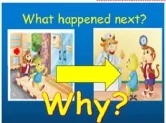
S20:Maybe medicine is丢了.
T:Maybe the medicine is lost.They come back to the hospital again.
S21:Maybe they忘记了东西.
T:Maybe they forget something.Let’s watch!(观看后半段)Watch and answer.Whythey come to the hospital again?

S22:BecauseMimiatea lotofice cream.It’sbad for her.
T:Can you saylike that.(给出表情提示)I don’t want to take any medicine.(不高兴地说)Look,here’s an ice cream shop.(兴奋地说)

T:If you are Micky,what would you say? You are the best friend.What would you say to Mimi?
S23:Oh, Mimi. You shouldn’t eat ice cream.I don’t eat ice cream,too.
T:You don’t eat ice cream,either.Good friend.
S24:Mimi,you should take some medicine and have a good rest.Let’s go home.
T:Good friend.
S25:Here’s anicecream shop.But we can’t eat it.You have a bad stomachache.Let’s go home.
T:Good friend,too.You are all Mimi’s good friend.But what did Mimi do?She atea lot of ice cream.She came back to the hospital again.
点评:采用图片环游的方式,让学生们通过图片想象、思考来自主建构故事情节,自主表达故事语言,这样的学习方式不再是被动的接受,而是主动的探寻,符合生本教育理念,符合学生的学习规律和身心发展特点。其中,高老师渗透了一个阅读策略,即通过上下文猜测词义,这些阅读策略的渗透,往往是教师最容易忽略的问题。
三、故事后
1.动画观看,模仿故事。
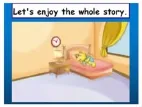
T:Do you like this story?
Ss:Yes,I do.
T: Now let’s enjoy the whole story.观看动画。
2.故事思考,拟定标题。

T:After enjoying the whole story,would you like to give the story a title?
S26:Mimi is ill.
S27:What’s wrong with you?
S28:What’s wrong with Mimi?
S29:Mimi and ice cream.
S30:Micky and Mimi.
S31:Go to see a doctor.
T:You all did a good job.Do you want to act the story?
Ss:Yes,we do.
3.小组合作,表演故事。
T:Before that,let’s follow the story.Pay attention to the red part and also the characters’facial expressions.Try to image youareMicky,Mimiandthe doctor.
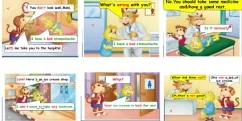

T:This time,let’s show.(请两组同学上台表演)
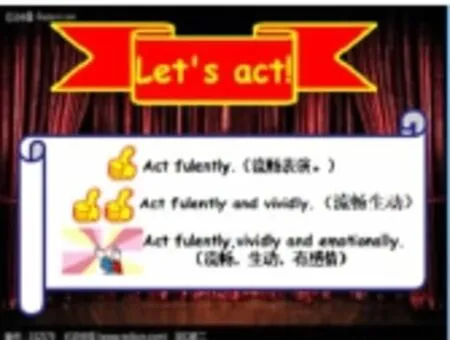
4.德育渗透,情感升华。
T:What can we learn from the story?

T:Mimi was so poor.Let’s make a get-well card for her.Let’s write!(请一位学生展示他的 card)When the people around us is ill,we can write a getwell card.What else can we do for them?

S32:We can buy some fruits for them.
S33:We can sing a song.
S34:We can tell a story.
S35:We can do the housework.
T:You areallgood boys and good girls.Now let’s share some pictures.

图片伴随《懂你》的背景伴奏音乐一一呈现上面的语言。
When ourgrandma isill,we can take good care of her.
When ourgrandpa is ill,we can wash an apple for him.
When our mother is ill,we can sing a song for her.
When our father is ill,we can share our photos with him.
When our friend is ill,we can send a storybook for him.
When our friend is ill,we can help her with her lessons.
When the people around us is ill,we can do a lot to show our love.
T:Today you alldid a good job.It’s time to say goodbye.
5.分层作业,故事延伸。
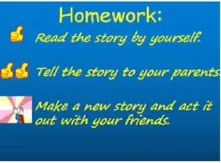
点评:高老师通过谈论故事,给故事提供标题,然后走出故事,走入生活,让学生顺着一根情感线,将语言学习作为工具进行交流,又融入学生自己的生活经验,体现了英语语言学习的人文性,将语言学习用到实处,学以致用。
评析
一、评价设计巧递进,学习目标妙达成
高老师这节课通过巧妙的评价设计,即故事留白,学生自主思考建构语言;小组合作表演故事;为Mimi写康复卡而建议,让层层递进的学习目标在课堂的学习过程中巧妙达成。高老师是一位拥有九年教龄、教学经验丰富的教师,她通过不断的课堂调控,让整个课堂呈现张弛有度、游刃有余的局面。
二、情境贯穿趣盎然,问题引领思灵动
高老师本节课的设计用了很多开放式的问题。比如,你认为故事主人公的性格是什么样的?假如你是小猴,你会说些什么?这些开放性的问题引领着学生兴趣盎然地在整个故事情境中思考、讨论,学生灵动的思维也让课堂充满了童真童趣。比如高老师提问:如果你是小猴子,看到冰激凌店,而作为小猫咪的好朋友,她病了,你会怎么说?有个学生回答:Oh,Mimi.You shouldn’t eat ice cream.I don’t eat ice cream,too.学生的回答多么稚嫩可爱,多么单纯善良。正是高老师的开放性问题的引领,让学生的思维灵动起来,语言丰富起来,内心得到表达,生活和学习充满正能量。
三、语言预设促生成,情义交融乃升华
在教学过程中,学生体现出的思维灵动和丰富的语言表达都源于高老师精心而又巧妙的教学设计。简单的评价设计却生成了精彩的课堂,其背后重要的原因就是高老师对各种教学理念的学习、思考和钻研。在这些教学理念的指引下,她设计出了情义交融的课堂。在这样的课堂上,语言学习不再是简单的鹦鹉学舌,不再是枯燥无聊的机械操练,而是灵动的表达。学生自己的想法通过所学的语言结构和功能得以得体自然地表达和交流。在最后的环节,高老师用一段带有配乐的图片诠释了爱、友情和亲情。这种教育不是贴标签式的灌输,而是水到渠成式的升华。学生由故事走入生活,读懂故事,感悟生活。
然而,教学是一门遗憾的艺术,任何看似完美的教学也会有瑕疵。所以,在这里,我想向高老师提出一个建议。在完成给小猫书写康复卡的环节后,高老师邀请一个学生站起来分享她写的康复卡并且贴在了板书的爱心框里。高老师可不可以把学生书写的康复卡投放到PPT,然后让全体学生一起来欣赏和纠错,这样比让学生站起来读效果会更好。毕竟我们还是要回归到英语的语言学习中去,只有正确的语言表达,才会有得体的语言沟通。

